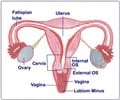
The researchers conducted studies, one of which had ovulating and non-ovulating women play the "dictator game".
In this popular economic experiment, a person is given a fixed amount of money that she can choose to share with another person.
"We found that ovulating women were much less willing to share when the other person was another woman. They became meaner to other women," said lead author of the study Kristina Durante.
Whereas non-ovulating women shared about 50 percent of the money with another woman, ovulating women shared only half as much, keeping the rest of the cash for themselves.
This research could have important implications for marketers, consumers and researchers.
Advertisement
For example, women indicated if they preferred to have a $25,000 car while other women got $40,000 cars (Option A) or have a $20,000 car while other women got $12,000 cars (Option B).
Advertisement
"What's interesting about this finding is that ovulating women are so concerned about their relative position that they are willing to take less for themselves just so that they could outdo other women," said study co-author Vladas Griskevicius.
The study was published in the Journal of Marketing Research.
Source-IANS









